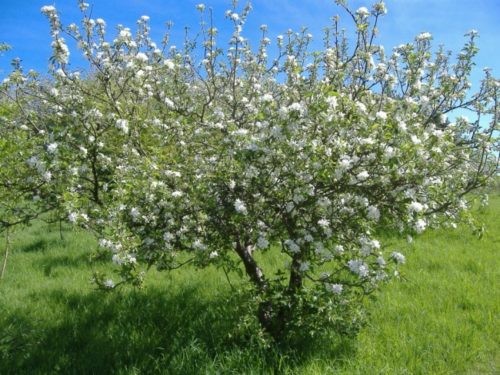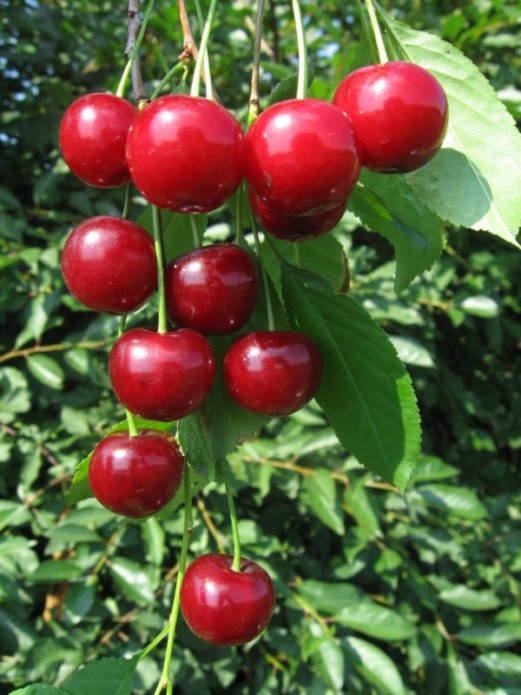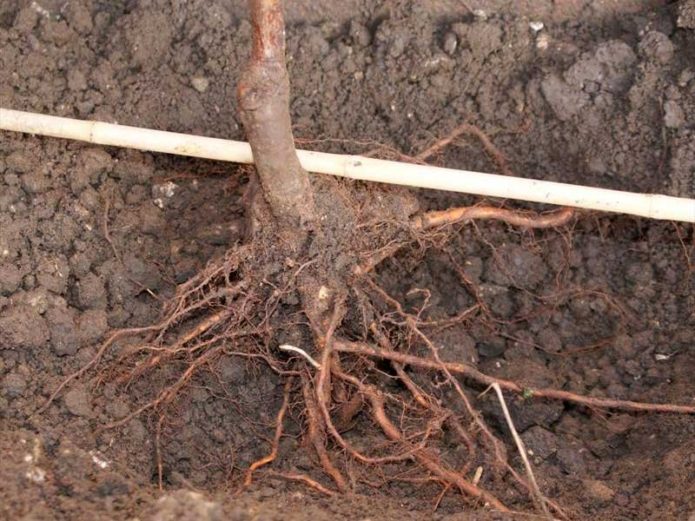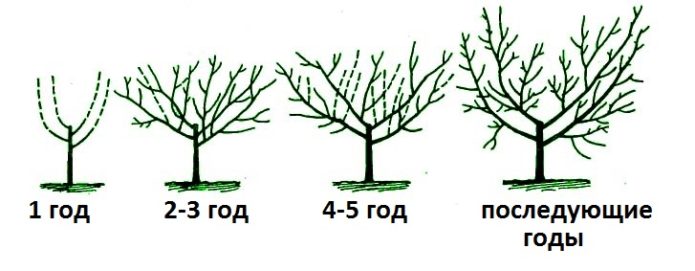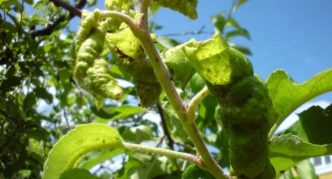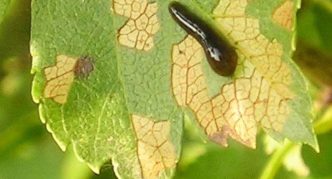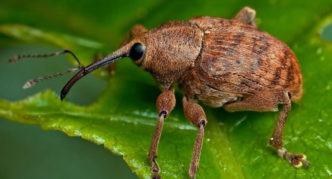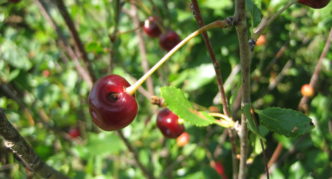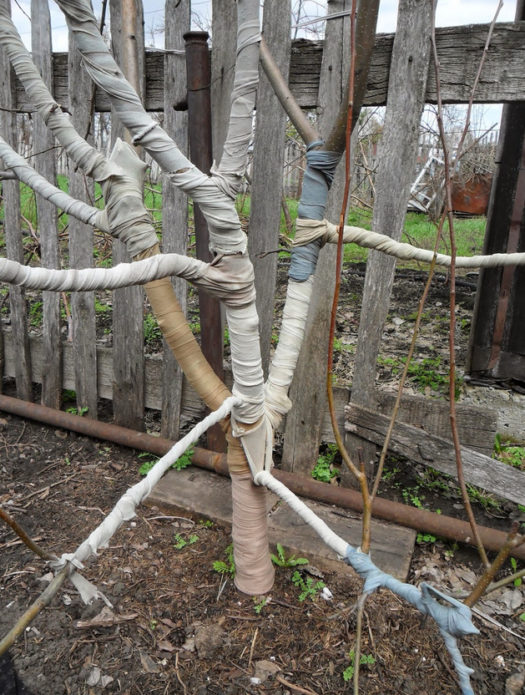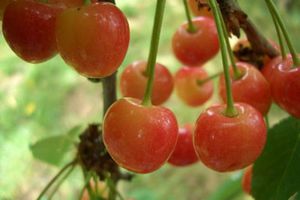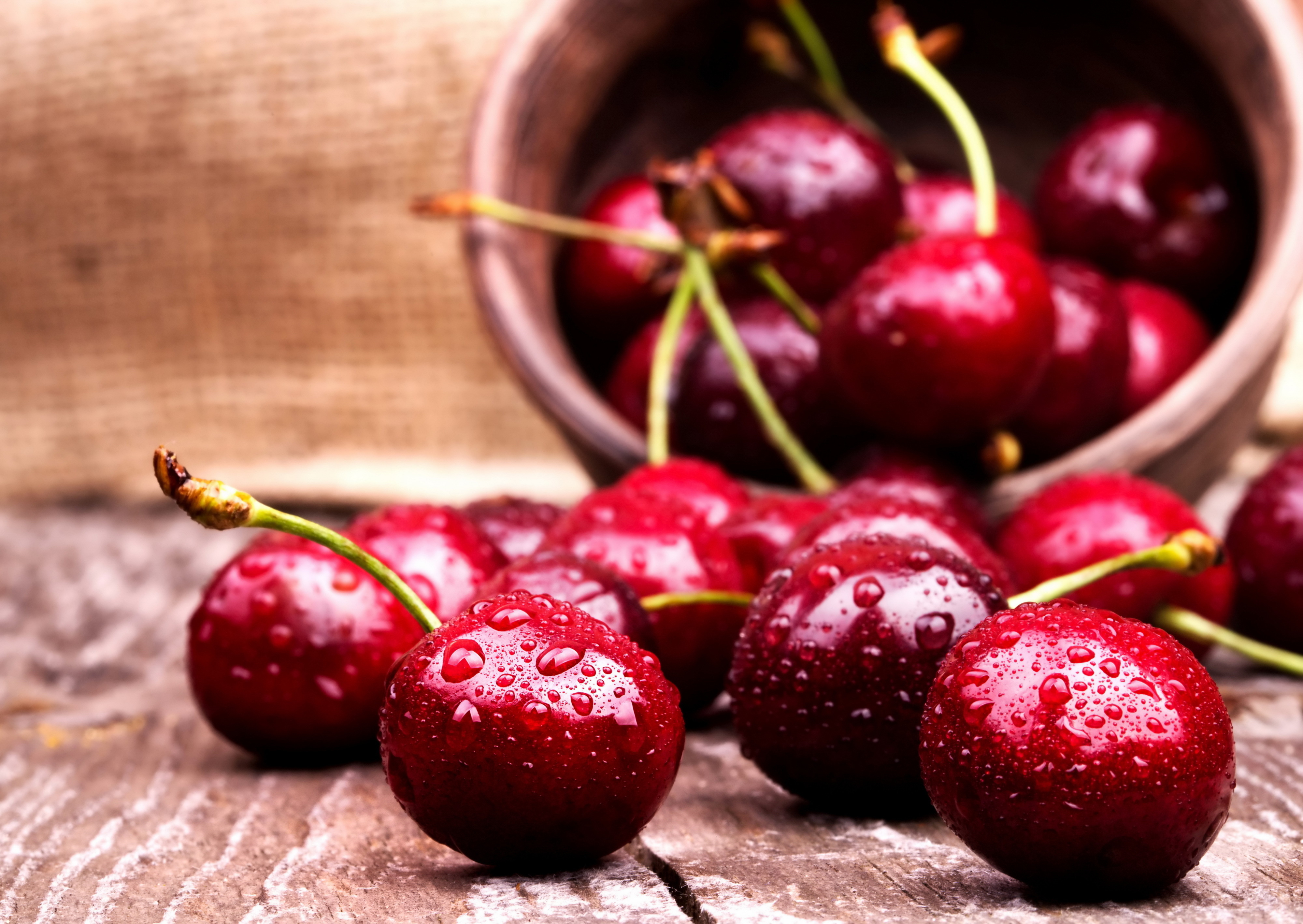Cherry is one of the favorite fruit and berry crops of summer residents. In the spring, during its short flowering period, it gives us a delightful sight. Its fruits are widely used in cooking. But cherry-cherry hybrids are superior to their parents. In recent years, the Malyshka variety of duke (cherry) has become popular among gardeners. It is a fast growing medium sized berry tree with slightly spreading branches, easy to grow.
Content
The history of the emergence of the variety of cherry Malyshka
Cherry Malyshka is a hybrid, the result of selection of Duke (a mixture of sweet and cherry) and Rannyaya variety. First introduced in the 90s of the XX century by the authors E.E. Kaverin, G.I. Dymnova and A.P. Kruglova at the experimental breeding station in the city of Saratov. Therefore, it received the name - Saratov baby. But among gardeners, and then in literature, the name Malyshka stuck.
Table: description of the cherry variety Saratov baby
| Name | Characteristic |
|---|---|
| Year | 1995 |
| Country variety | Russia |
| Fruit color | Red |
| Fruit taste | Sweet and sour |
| Height of an adult plant | 2-2.5 meters |
| Shine | Requires good sunlight and sheltered from the winds. In a shaded area subject to strong winds, the seedling will not grow and develop well. |
| Soil / Moisture | It grows well on fertile soils: chernozems, floodplain light loams, chestnut, sandy loams, etc. Fertile soil should be loose and structural, breathable, capable of providing sufficient oxygen access to the roots. |
| Frost resistance | High |
| Pollination | The plant is self-fertile - for pollination it is planted with other varieties of cherries in the neighborhood. |
The fruits of the Saratov baby
Fruiting of the hybrid occurs at 3 or 4 years. The tree forms a small arched crown. Fruits are laid on flower clusters.
The variety is early maturing, blooms in early May.
The fruits ripen in the 1st decade of June. The harvest peaks at the end of the month. Large berries weigh 4–5 grams. The flesh of the fruit is dense, juicy, dark red, evenly colored. The stone is small, well separated from the pulp. The fruits contain:
- 14.5% dry matter,
- 7.5% sugar
- 8 mg / 100 g of ascorbic acid,
- 1.2% other acids.
The average harvest per tree is 15 kilograms. Transportability is excellent. In cool conditions, the harvested fruits can be stored for up to two weeks. The species is winter-hardy, resistant to diseases (including coccomycosis and moniliosis). The main purpose of the variety is table.
The value of the Malyshka cherry variety:
- early ripeness,
- high yield,
- practically does not freeze,
- small roots do not reach the groundwater,
- excellent taste properties of fruits,
- resists diseases of different etymologies,
- berries are easy to pick,
- good transportability.
The disadvantages of the variety include self-infertility - for pollination, the Baby is planted next to other varieties of cherries, and insufficiently strong fastening of ripe fruits - during a strong and gusty wind, some berries fall off.
Features of growing and caring for Malyshka cherries
To get a good harvest, you need to choose a bright space for your cherry orchard, as well as good planting material.
Sapling selection
To purchase a seedling of the desired variety, contact your nursery or specialty store. It is desirable that it was an annual plant, since their survival rate is better. The height of such a seedling is about one meter with a crown of 8-10 branches. Before buying a plant you like, pay attention to the grafting site (5–8 cm above the root collar): here the stem is slightly thickened. In general, it should be smooth and even. The twigs are strong and bendable. If you slightly scratch the twig, then there should be a green cambium under the bark, not dry wood. Check the roots of the seedling. In a promising plant, they are light in color, well developed, have a length of about 40 cm.If the seedling is in a container, take it out: the roots should firmly entangle an earthen ball, not allowing it to crumble.
Before planting, in order to avoid the development of diseases and pests, it is advisable to soak the plant in water for 7-8 hours with the addition of a small amount of manganese.
Planting a seedling
For planting cherries Baby, as for any duke, try choose a place protected from flooding and strong winds... Dig up the soil, remove the weeds. The baby's bush is small, so place the planting holes at a distance of 2 to 3 meters. But consider the location of pollinating cherries at a distance of no more than 30-40 meters.
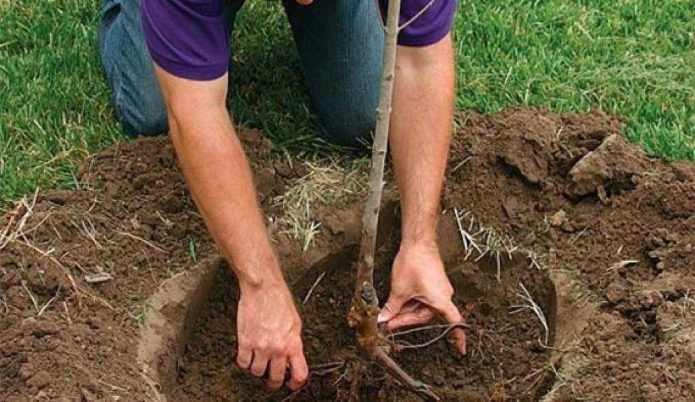
The roots of the tree should spread evenly to the sides and not rest against the walls of the planting pit
Place the seedling in the center of the planting hole and gently straighten the roots. Place the grafting site above the soil.
For the best survival of the seedling, make sure that the soil around it does not dry out... In the future, four waterings will be enough per season:
- during the flowering period,
- during fruit ripening,
- after the harvest is complete,
- in the first half of October (water-charging irrigation).
As a rule, an annual tree requires about 10 liters of water, an adult - from 20 to 30. In a dry summer, spend additional watering, and in a rainy one, give them up altogether. The next day after watering, do not loosen the soil very deeply and cover it with any material (for example, dried cut grass).
Fertilization
Saratov baby has been bearing fruit for over 15 years. For stable and high yields, feed the plant correctly and in the right amount. Remember that nitrogen must be present in the top dressing in the spring.
Table: dosage and composition of fertilizers
| Terms of introduction | Top dressing composition and dosage |
|---|---|
| 1 year after planting | in spring: scatter 80–100 g of urea over the trunk circle, water and loosen the earth. |
| 2 years after planting | in spring: dissolve 15 g of ammonium nitrate or 10 g of urea in 5 liters of water. |
| 3 years after planting | • in spring: 100-200 g of urea for a bush; • in autumn: 100 g of potassium sulfate and 300 g of double superphosphate. |
| After 4 and 5 years | in spring: pour with Ammofoski solution (30 g per 10 l of water). |
| After 6 years | • in spring: 300 g of urea in the trunk circle; • in autumn: 150 g of potassium sulfate, 500 g of double superphosphate and 40 kg of rotted manure. |
Further fertilize the trees after a year.
Pruning and shaping the crown
In order to save space and ease of harvesting, form the Malyshka cherry with a bush 2–2.5 m high with 4–5 skeletal branches. To limit the vertical growth of the seedling, cut off the top of the seedling on the day of planting. The optimal light regime inside the crown will allow you to get an earlier high quality harvest.To do this, shorten the side strong branches by about 1/3, and remove the weak ones by a ring. The main part of the fruits of the dukes is laid on bouquet branches located on older wood. Therefore, the annual shortening of annual shoots is the way to increase the yield..
Every spring, preferably before the first leaves appear, carry out formative pruning. Your task is to direct the branches outward from the trunk, spread the approaching branches and, if necessary, reduce their exposure.
Video: how to form a cherry crown
https://youtube.com/watch?v=fRC35crNVYs
Prevention of diseases and pests
The Malyshka variety can withstand many diseases, but for their prevention, the following measures are recommended:
- loosen the soil regularly,
- destroy root growth, weeds,
- remove fallen leaves,
- cover up cracks in the plant,
- remove the volunteers,
- carry out sanitary pruning.
Among garden pests, the main enemies of cherries, like other horticultural crops, are:
- aphid,
- mucous sawflies,
- moths,
- weevils,
- caterpillars.
Therefore, inspect your plantings about once every 10 days.
Photo gallery: signs of pests on cherries
- Aphids appear on young leaves of a plant
- The slime sawfly larva looks like a leech and a slug
- Moth moth larvae can destroy the entire crop
- The weevil feeds on buds, flowers, young foliage, ovaries and cherry fruits, laying up to 120 eggs
- Weevil-damaged cherry fruits
For pest control, try simple methods first. At the beginning of the cherry orchard bloom, arrange or hang containers with jam diluted in water. Many pest butterflies, attracted by the smell of fermentation, will die in the prepared solution. Change the contents of the bait every 7-10 days. Sometimes it is enough to spray the plants with green soap (200–300 grams per bucket of warm water). In extreme cases, use insecticides: for example, Inta-vir (1 tablet per 5 liters of water) or Actellik (2 ml per 2 liters of water).
Preparing for winter
The Malyshka variety does not need special preparation for winter. But in order to avoid damage from the sun's rays and rodents, you can wrap its trunk in burlap.
Dwarf rootstock for cherries Baby
Malyshka, a small and very easy-to-grow variety that yields like a whole tree, was bred using an antipka rootstock. (What is grafted, a stalk or bud of the desired variety, is called a scion, and the one where it is grafted is called a stock.) Thanks to this stock, the cherry plant has become more winter-hardy and adapted to Russian weather conditions.
Video: grafting cherries on cherries
If desired, novice gardeners can master the technique of plant grafting.
Video: stock for cherries and cherries
Reviews
I would definitely like to plant the baby due to the fact that it is early and large-fruited.
The baby, apparently, was perfectly pollinated by someone - unlike all my cherries, it was all covered in berries. The berries are large, ripe very early - in July. In general, I liked it very much!
I have a very large baby growing on my plot, pollination is excellent. It ripens at the same time as the cherry.
Cherry Baby is an unpretentious tree. The correct choice of planting material and little care will allow you to fully enjoy the delicious and juicy fruits.
